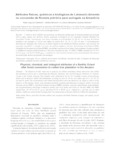Please use this identifier to cite or link to this item:
http://www.alice.cnptia.embrapa.br/alice/handle/doc/1059528| Title: | Atributos físicos, químicos e biológicos de Latossolo Amarelo na conversão de floresta primária para seringais na Amazônia. |
| Authors: | ZANINETTI, R. A.  MOREIRA, A.   MORAES, L. A. C.   |
| Affiliation: | REAN AUGUSTO ZANINETTI, Universidade Federal do Acre; ADONIS MOREIRA, CNPSO; LARISSA ALEXANDRA CARDOSO MORAES, CNPSO. |
| Date Issued: | 2016 |
| Citation: | Pesquisa Agropecuária Brasileira, Brasília, DF, v. 51, n. 9, p. 1061-1068, set. 2016. |
| Description: | RESUMO: O objetivo deste trabalho foi quantificar os efeitos da substituição da floresta primária por seringal (Hevea spp.), quanto aos atributos físicos, químicos e biológicos de um Latossolo Amarelo distrófico na Amazônia Central. Amostras de solo foram coletadas na profundidade de 0,0?0,1 m, em área de floresta primária e em seringais de 2,0 ha com idades de plantio de 6, 16, 18, 19, 20 e 45 anos. O reflorestamento das áreas por seringais não minimiza os efeitos negativos da retirada da floresta primária, com aumento do quociente metabólico e redução nos teores de carbono orgânico, carbono da biomassa microbiana (CBM), nitrogênio da biomassa microbiana (NBM), porosidade, enzimas (arilsulfatase, β-glucosidase e β-galactosidase) e substâncias húmicas (ácidos húmicos e fúlvicos e humina) do solo. O CBM e o NBM variaram de 291,97 a 615,27 μg g-1 e de 65,76 a 98,58 μg g-1, e mostram-se como os atributos mais sensíveis às alterações decorrentes da substituição da floresta primária por seringais. ABSTRACT: The objective of this work was to quantify the effects of primary forest conversion into rubber tree plantation (Hevea spp.), concerning the physical, chemical, and microbiological attributes of a Xanthic Oxisol in the Central Amazon. Soil samples were collected at the 0.0?0.1 m depth in areas of the primary forest and of adjacent rubber tree plantations covering an area of 2.0 ha, with plant ages of 6, 16, 18, 19, 20, and 45 years. The Reforestation with rubber tree plantation does not minimize the negative effects of the removal of the primary forest, with increased metabolic quotient and reduction of organic carbon, microbial biomass carbon (MBC), microbial biomass nitrogen (MBN), porosity, enzymes (arilsulfatase, β-glucosidase, and β-galactosidase), and humic substances (humic and fulvic acids, and humin) in the soil. MBC and MBN ranged from 291.97 to 615.27 μg g-1 and from 65.76 to 98.58 μg g-1, respectively, and they are the most sensitive attributes to alterations resulting from the replacement of primary forest by rubber tree plantations. |
| Thesagro: | Fertilidade Seringueira Solo |
| ISSN: | 1678-3921 |
| DOI: | 10.1590/S0100-204X2016000900005 |
| Type of Material: | Artigo de periódico |
| Access: | openAccess |
| Appears in Collections: | Artigo em periódico indexado (CNPSO)  |
Files in This Item:
| File | Description | Size | Format | |
|---|---|---|---|---|
| 0100204Xpab51091061.pdf | 360,95 kB | Adobe PDF |  View/Open |









